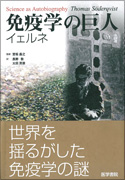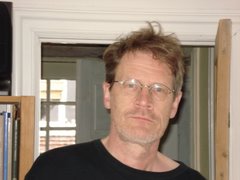1st European Auto/Biography Association meeting in Amsterdam 29-31 October
'Science as Autobiography' lost in translation -- 免疫学の巨人イェルネ
A couple of months ago I received a package which, to my great joy and surprise, contained five copies of my biography of Niels K. Jerne (Science as Autobiograhy, Yale UP, 2003) in a Japanese translation. 
The rights were sold to the big Tokyo publisher Igaku Shoin already in 2004. But I never heard anything from them, and occasional inquiries never yielded anything but polite avoidance replies. So it is very pleasing to see it in print at last.
My knowledge of Japanese is less than rudimentary so I churned the title (免疫学の巨人イェルネ) through Google Translate and got another---but less joyful---surprise: 'giants immunology jerne'! Could be a Google blunder, of course, but it doesn't even remotely looks like anything like 'autobiography'.
The Japanese title is a pretty far shot from (well, even the opposite of) the idea behind the original title. The thrust of the book is that Jerne's theoretical work in immunology was a metaphorical projection of his understanding of himself. His science was literally his autobiography. Accordingly Science as Autobiography is a case-study of an auto/biographical approach to understanding the construction of scientific knowledge. My claim is that the inner life of the scientist constitutes an emotional and existential context for the production of scientific knowledge which is as important as the cultural or social contexts.
Most reviewers got this message right (like Fred Tauber in Bull. Hist. Med.). But, alas, it gets completely lost in the translation. The new title erroneously classifies the biography into one of these hagiographical works that I very consciously tried to stay away from. Maybe some immunologists believe Jerne was a 'giant', but I certainly didn't portray him as such. It simply wasn't the intention of the book. The summary on their website (in Google translation) isn't better.
That said, it's great that the book is now available for a wider Japanese readership. To Igaku Shoin's credit, they have kept the whole note apparatus and the full bibliography, and all the illustrations are intact too. And it's very nicely set and bound, and (as far as I can see :-) there are no typos.
Obituary writing journalists get together
A too long sabbatical ...
Friendship in science
Plato and Aristotle did it, Cicero did it, and many other classical authors too. Montaigne wrote a long essay on it, and Henry David Thoreau a whole book. Friendship is one of the perennial topics in the history of philosophical thought.
Some sociologists say that friendship relations have perhaps never been as strong as they are today, when individualism flourishes and traditional social institutions and solidarities have broken down, at least in Western societies.
Now, Western societies are also science-based societies -- and science is an extremely individualist enterprise -- ergo, one could expect friendship to be quite a pervasive kind of social relationship in science, technology and medicine, including biomedicine. In his autobiography (What Mad Pursuit, 1988) Francis Crick said that friendship was crucial for scientific collaboration: "certainly you have to be personal friends" (on p. 93).
Crick's point is underlined by the ubiquitous references to friendship in book prefaces. In almost every book, in the humanities as well in the sciences, authors thank their colleagues and/or friends. And even if they may exaggerate, or include people they would never dream of having a really friendly relationship with, the ubiquity of the term 'friend' seem to reflect at least an widespread expectation that friendship in crucial for scholarship.
What has been written in history of science and science studies? The other day I searched through some of the standard book and article data bases (Arts & Humanities Citation Index and Google Scholar; and RLG's Eureka for history of science) -- and found almost nothing.
True, historians of science, technology and medicine have written quite a lot about concrete friendships, but I didn't really find anything about friendship as a social or cultural category in the HoSTM- and STS-literature.
The only interesting item I did in fact find was one made in passing by veteran STS-scholar Evelyn Fox Keller who wrote in a memorial article to one of her old friends, mathematician Lee Segel, that in their case friendship came first: "work grew out of friendship, and gradually became the very medium of friendship" (E. F. Keller, "Science as a medium for friendship: How the Keller–Segel models came about", Bulletin of Mathematical Biology, vol. 68, 1033–1037, 2006; on p. 1034).
Maybe there is a rich literature on friendship in science that I have missed in this preliminary literature search? But it may also be the case that friendship has been overlooked among historians of STM and STS scholars.
Maybe the general opinion corresponds to the naïve idea expressed by F.J. Ayala that "scientists are inclined to transcend ideology, nationality, friendship, monetary interest and other prejudices when the mettle of scientific knowledge is at stake" ("On the scientific method, its practice and pitfalls", History and Philosophy of the Life Sciences, vol. 16, 205-240 1994).
That kind of naïvité has been surpassed when it comes to ideology, nationality and monetary interest, but may still be valid with respect to friendship. I don't know. Does anyone have any good ideas?
(is also published here: http://www.corporeality.net/museion/2007/08/03/friendship-in-science/
Gosh
Beyond Contextualism: The Concrete Individual as a Focus Point
This presentation investigates the role of the genre of writing about individual scientists (biography) in relation to the writing of historical accounts of science (historiography). From the professional vantage point of history of science, scientific biography is normatively considered an auxilliary genre to science historiography (an ancilla historiae) and as a tool for contextualizing science in history. Such a normative perspective makes it difficult to appreciate the full richness of the genre, however. In practice, biographies of scientists have also been written as contributions to understanding singular lives, e.g., for commemorative and eulogistic purposes, as moral investigations, or as tools for understanding oneself. These generic roles - which have been prominent throughout the history of the genre and are also operative in biographical writing today - may be more or less overlapping in the same biographical work, but their analytical separation may help improve the critical evaluation of the genre, e.g., in biographical book reviewing practice. Most importantly, these generic roles point to a reversal of the function of the ancilla historiae-role of the genre, viz., that the historiography of science can as well be seen as an ancilla biographiae, a mere context for understanding individual scientists, their ambitions and expectations.The paper is part of a panel session organised by Noretta Koertge titled "Scientific Biography: Constructing the Human Element in the Production of Science". The participants are (in addition to myself): James Capshew (Indiana University), "Portraits of the Sex Researcher: The Cultural Production of Kinsey"; Michael Sokal (Worcester Polytechnic Institute), "Psychology as a Biographer's Tool: Developing Insights into Scientific Careers"; and Noretta Koertge (Indiana University), "Reflections on the New DSB" (Noretta is Editor-in-Chief of the New Dictionary of Scientific Biography, an eight volume extension of the original DSB that will appear late in 2007. Here's the session abstract:
Nye's recent article in Isis documents the wide spread interest in the life stories of scientists. From the sidebars in school science books to biographical dictionaries and prize-winning scholarly monographs, scientific biography is an increasingly important genre. The purpose of this panel is to reflect on issues that arise when historians of science write biographies. There are the perennial puzzles about selection, emphasis, the goals of the author, and the interests of the audience that always arise when doing history. We want to focus on current problems and possibilities. (Examples range from the difficulty of describing the technical achievements of recent scientists to concerns about how the unsavory details of a scientist's life may be misused.) Each panelist will make a short presentation and then we hope to involve them and the audience in an open discussion. The participants on this panel are all currently engaged in producing and reflecting on scientific biography.
Obiturial prosopography of contemporary biomedicine
Biographies come in many varieties. One of the least conspicuous, but also most read, is the obituary -- a public notice of a recently deceased person, usually in the form of a short life description, often in a newspaper or a popular magazine. Many more people get obituaries than short biographical articles, not to mention full-scale scholarly biographies; in fact, most people of some public importance get at least a minor notice in the form of an obituary.
Obituaries are a potentially very interesting material for representing the contemporary history of biomedicine. Between the lines about the portrayed person the obituary presents pieces (like single pixels on a screen) for a picture of a more complex history, and by accumulating large numbers of obituaries the pixels coalesce and form historical patterns. This way of combining of singular live-descriptions into a larger pattern is what historians call prosopography.
The number of obituaries about biomedical practitioners is growing rapidly. Many who were active in the heroic period of molecular biology in the 1950s and 1960s have already passed away, and now the great names in biovisualisation technologies are following them in turn. For example, in the last couple of weeks many newspapers and magazines have carried obituaries of the 'father of magnetic resonance imaging', Paul Lauterbur (see e.g., this one in The Economist of April 7).
What's interesting about this kind of 'obituarial' contemporary popular history is the variability between the accounts. With few notable exceptions, most scientists and medical people only get one book-size scholarly biography or biographical article (if they ever get one at all). But popular obituaries, like that of Lauterbur, are not only much more frequent -- they also come in many versions written by several obituarists for many different newspapers, journals and magazines, and therefore give a much more composite picture of the history of MRI. Together with obituaries of other pioneers in biovisualisation they add up to what might be called an obiturial prosopography of the field.
